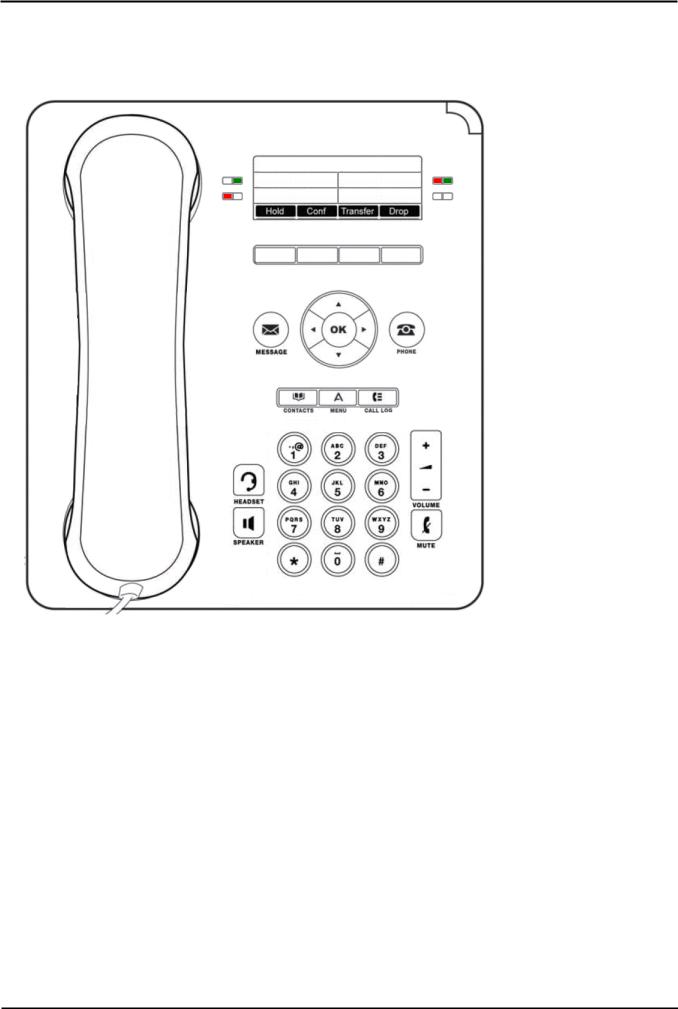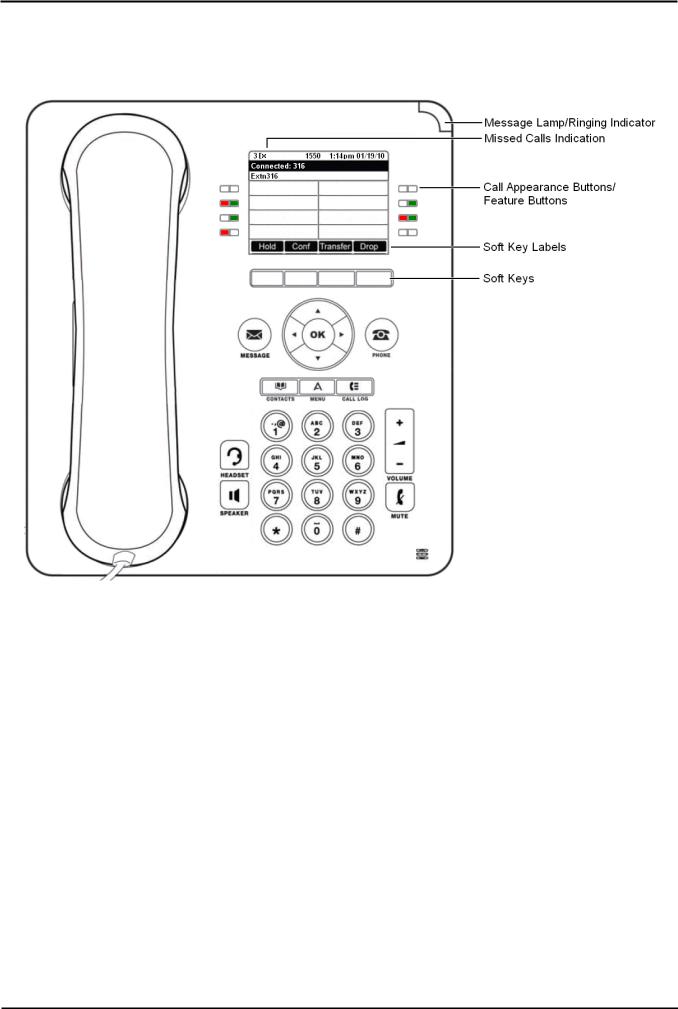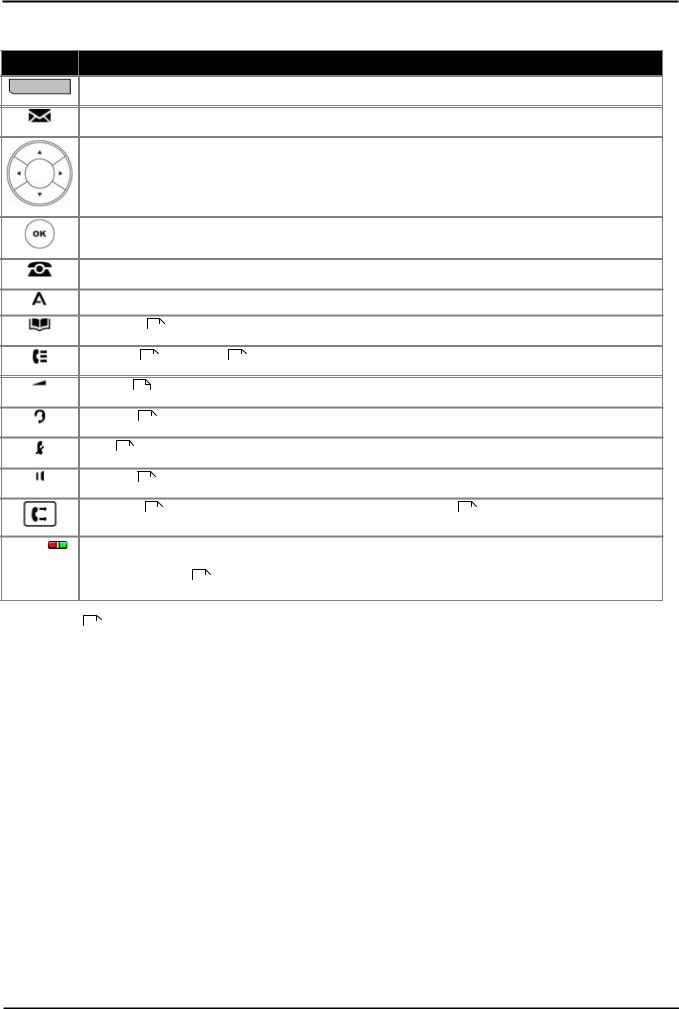Avaya IP Office 9.0 User Manual

IP Office 9.0
9500 Series User Guide
Issue 06d - (17 September 2013)

© 2013 AVAYA All Rights Reserved.
Notice
While reasonable efforts have been made to ensure that the information in this document is complete and accurate at the time of printing, Avaya assumes no liability for any errors. Avaya reserves the right to make changes and corrections to the information in this document without the obligation to notify any person or organization of such changes.
For full support, please see the complete document, Avaya Support Notices for Hardware Documentation, document number 03–600759. For full support, please see the complete document, Avaya Support Notices for Software Documentation, document number 03–600758. To locate this document on our website, simply go to http://www.avaya.com/support and search for the document number in the search box.
Documentation disclaimer
“Documentation” means information published by Avaya in varying mediums which may include product information, operating instructions and performance specifications that Avaya generally makes available to users of its products. Documentation does not include marketing materials. Avaya shall not be responsible for any modifications, additions, or deletions to the original published version of documentation unless such modifications, additions, or deletions were performed by Avaya. End User agrees to indemnify and hold harmless Avaya, Avaya's agents, servants and employees against all claims, lawsuits, demands and judgments arising out of, or in connection with, subsequent modifications, additions or deletions to this documentation, to the extent made by End User.
Link disclaimer
Avaya is not responsible for the contents or reliability of any linked websites referenced within this site or documentation provided by Avaya. Avaya is not responsible for the accuracy of any information, statement or content provided on these sites and does not necessarily endorse the products, services, or information described or offered within them. Avaya does not guarantee that these links will work all the time and has no control over the availability of the linked pages.
Warranty
Avaya provides a limited warranty on its hardware and Software (“Product(s)”). Refer to your sales agreement to establish the terms of the limited warranty. In addition, Avaya’s standard warranty language, as well as information regarding support for this Product while under warranty is available to Avaya customers and other parties through the Avaya Support website: http://support.avaya.com. Please note that if you acquired the Product(s) from an authorized Avaya Channel Partner outside of the United States and Canada, the warranty is provided to you by said Avaya Channel Partner and not by Avaya. “Software” means computer programs in object code, provided by Avaya or an Avaya Channel Partner, whether as stand-alone products or pre-installed on hardware products, and any upgrades, updates, bug fixes, or modified versions.
Licenses
THE SOFTWARE LICENSE TERMS AVAILABLE ON THE AVAYA WEBSITE, HTTP://SUPPORT.AVAYA.COM/LICENSEINFO ARE APPLICABLE TO ANYONE WHO DOWNLOADS, USES AND/OR INSTALLS AVAYA SOFTWARE, PURCHASED FROM AVAYA INC., ANY AVAYA AFFILIATE, OR AN AUTHORIZED AVAYA CHANNEL PARTNER (AS APPLICABLE) UNDER A COMMERCIAL AGREEMENT WITH AVAYA OR AN AUTHORIZED AVAYA CHANNEL PARTNER. UNLESS OTHERWISE AGREED TO BY AVAYA IN WRITING, AVAYA DOES NOT EXTEND THIS LICENSE IF THE SOFTWARE WAS OBTAINED FROM ANYONE OTHER THAN AVAYA, AN AVAYA AFFILIATE OR AN AVAYA AUTHORIZED AVAYA CHANNEL PARTNER; AVAYA RESERVES THE RIGHT TO TAKE LEGAL ACTION AGAINST YOU AND ANYONE ELSE USING OR SELLING THE SOFTWARE WITHOUT A LICENSE. BY INSTALLING, DOWNLOADING OR USING THE SOFTWARE, OR AUTHORIZING OTHERS TO DO SO, YOU, ON BEHALF OF YOURSELF AND THE ENTITY FOR WHOM YOU ARE INSTALLING, DOWNLOADING OR USING THE SOFTWARE (HEREINAFTER REFERRED TO INTERCHANGEABLY AS “YOU” AND “END USER”), AGREE TO THESE TERMS AND CONDITIONS AND CREATE A BINDING CONTRACT BETWEEN YOU AND AVAYA INC. OR THE APPLICABLE AVAYA AFFILIATE (“AVAYA”).
Avaya grants you a license within the scope of the license types described below, with the exception of Heritage Nortel Software, for which the scope of the license is detailed below. Where the order documentation does not expressly identify a license type, the applicable license will be a Designated System License. The applicable number of licenses and units of capacity for which the license is granted will be one (1), unless a different number of licenses or units of capacity is specified in the documentation or other materials available to you. “Designated Processor” means a single stand-alone computing device. “Server” means a Designated Processor that hosts a software application to be accessed by multiple users.
License type(s)
Designated System(s) License (DS). End User may install and use each copy of the Software only on a number of Designated Processors up to the number indicated in the order. Avaya may require the Designated Processor(s) to be identified in the order by type, serial number, feature key, location or other specific designation, or to be provided by End User to Avaya through electronic means established by Avaya specifically for this purpose.
Concurrent User License (CU). End User may install and use the Software on multiple Designated Processors or one or more Servers, so long as only the licensed number of Units are accessing and using the Software at any given time. A “Unit” means the unit on which Avaya, at its sole discretion, bases the pricing of its licenses and can be, without limitation, an agent, port or user, an e-mail or voice mail account in the name of a person or corporate function (e.g., webmaster or helpdesk), or a directory entry in the administrative database utilized by the Software that permits one user to interface with the Software. Units may be linked to a specific, identified Server.
Database License (DL). End User may install and use each copy of the Software on one Server or on multiple Servers provided that each of the Servers on which the Software is installed communicates with no more than a single instance of the same database.
CPU License (CP). End User may install and use each copy of the Software on a number of Servers up to the number indicated in the order provided that the performance capacity of the Server(s) does not exceed the performance capacity specified for the Software. End User may not reinstall or operate the Software on Server(s) with a larger performance capacity without Avaya’s prior consent and payment of an upgrade fee.
9500 Series User Guide |
Page 2 |
IP Office 9.0 |
Issue 06d (17 September 2013) |

Named User License (NU). You may: (i) install and use the Software on a single Designated Processor or Server per authorized Named User (defined below); or (ii) install and use the Software on a Server so long as only authorized Named Users access and use the Software. “Named User”, means a user or device that has been expressly authorized by Avaya to access and use the Software. At Avaya’s sole discretion, a “Named User” may be, without limitation, designated by name, corporate function (e.g., webmaster or helpdesk), an e-mail or voice mail account in the name of a person or corporate function, or a directory entry in the administrative database utilized by the Software that permits one user to interface with the Software.
Shrinkwrap License (SR). You may install and use the Software in accordance with the terms and conditions of the applicable license agreements, such as “shrinkwrap” or “clickthrough” license accompanying or applicable to the Software (“Shrinkwrap License”).
Heritage Nortel Software
“Heritage Nortel Software” means the software that was acquired by Avaya as part of its purchase of the Nortel Enterprise Solutions Business in December 2009. The Heritage Nortel Software currently available for license from Avaya is the software contained within the list of Heritage Nortel Products located at http://support.avaya.com/LicenseInfo under the link “Heritage Nortel Products”. For Heritage Nortel Software, Avaya grants Customer a license to use Heritage Nortel Software provided hereunder solely to the extent of the authorized activation or authorized usage level, solely for the purpose specified in the Documentation, and solely as embedded in, for execution on, or (in the event the applicable Documentation permits installation on non-Avaya equipment) for communication with Avaya equipment. Charges for Heritage Nortel Software may be based on extent of activation or use authorized as specified in an order or invoice.
Copyright
Except where expressly stated otherwise, no use should be made of materials on this site, the Documentation, Software, or hardware provided by Avaya. All content on this site, the documentation and the Product provided by Avaya including the selection, arrangement and design of the content is owned either by Avaya or its licensors and is protected by copyright and other intellectual property laws including the sui generis rights relating to the protection of databases. You may not modify, copy, reproduce, republish, upload, post, transmit or distribute in any way any content, in whole or in part, including any code and software unless expressly authorized by Avaya. Unauthorized reproduction, transmission, dissemination, storage, and or use without the express written consent of Avaya can be a criminal, as well as a civil offense under the applicable law.
Virtualization
Each vAppliance will have its own ordering code. Note that each instance of a vAppliance must be separately ordered. If the end user customer or Avaya channel partner would like to install two of the same type of vAppliances, then two vAppliances of that type must be ordered.
Each Product has its own ordering code. Note that each instance of a Product must be separately licensed and ordered. “Instance” means one unique copy of the Software. For example, if the end user customer or Avaya channel partner would like to install two instances of the same type of Products, then two Products of that type must be ordered.
Third Party Components
“Third Party Components” mean certain software programs or portions thereof included in the Software that may contain software (including open source software) distributed under third party agreements (“Third Party Components”), which contain terms regarding the rights to use certain portions of the Software (“Third Party Terms”). Information regarding distributed Linux OS source code (for those Products that have distributed Linux OS source code) and identifying the copyright holders of the Third Party Components and the Third Party Terms that apply is available in the Documentation or on Avaya’s website at: http://support.avaya.com/Copyright. You agree to the Third Party Terms for any such Third Party Components.
Note to Service Provider
The Product may use Third Party Components that have Third Party Terms that do not allow hosting and may need to be independently licensed for such purpose.
Preventing Toll Fraud
“Toll Fraud” is the unauthorized use of your telecommunications system by an unauthorized party (for example, a person who is not a corporate employee, agent, subcontractor, or is not working on your company's behalf). Be aware that there can be a risk of Toll Fraud associated with your system and that, if Toll Fraud occurs, it can result in substantial additional charges for your telecommunications services.
Avaya Toll Fraud intervention
If you suspect that you are being victimized by Toll Fraud and you need technical assistance or support, call Technical Service Center Toll Fraud Intervention Hotline at +1-800-643-2353 for the United States and Canada. For additional support telephone numbers, see the Avaya Support website: http://support.avaya.com. Suspected security vulnerabilities with Avaya products should be reported to Avaya by sending mail to: securityalerts@avaya.com.
Trademarks
The trademarks, logos and service marks (“Marks”) displayed in this site, the Documentation and Product(s) provided by Avaya are the registered or unregistered Marks of Avaya, its affiliates, or other third parties. Users are not permitted to use such Marks without prior written consent from Avaya or such third party which may own the Mark. Nothing contained in this site, the Documentation and Product(s) should be construed as granting, by implication, estoppel, or otherwise, any license or right in and to the Marks without the express written permission of Avaya or the applicable third party.
Avaya is a registered trademark of Avaya Inc.
All non-Avaya trademarks are the property of their respective owners. Linux® is the registered trademark of Linus Torvalds in the U.S. and other countries.
9500 Series User Guide |
Page 3 |
IP Office 9.0 |
Issue 06d (17 September 2013) |

Downloading Documentation
For the most current versions of Documentation, see the Avaya Support website: http://support.avaya.com.
Contact Avaya Support
See the Avaya Support website: http://support.avaya.com for product notices and articles, or to report a problem with your Avaya product. For a list of support telephone numbers and contact addresses, go to the Avaya Support website: http://support.avaya.com, scroll to the bottom of the page, and select Contact Avaya Support.
9500 Series User Guide |
Page 4 |
IP Office 9.0 |
Issue 06d (17 September 2013) |

Contents
Contents
9. Headset/Handsfree Operation
1. |
Introduction |
|
9.1 Headset Operation..................................................................... |
48 |
|
||
|
9.1.1 Headset............................................................................Volume |
48 |
|
||||
1.1 |
Important Safety.....................................................................Information |
11 |
9.1.2 Default............................................................................Handsfree Audio Path |
48 |
|
||
1.2 |
9504 Telephone..................................................................... |
12 |
9.2 Handsfree .....................................................................Speaker Operation |
49 |
|
||
1.3 |
9508 Telephone..................................................................... |
13 |
9.2.1 Speaker............................................................................Volume |
49 |
|
||
1.4 |
Button Modules..................................................................... |
14 |
9.2.2 Default............................................................................Handsfree Audio Path |
49 |
|
||
1.5 |
Phone Keys..................................................................... |
15 |
10.Contacts/Directory |
|
|
||
1.6 |
Status Letters..................................................................... |
17 |
|
|
|||
1.7 |
The Phone Stand |
17 |
10.1 |
Managing.....................................................................External Contacts |
52 |
|
|
10.2 |
Viewing Contacts Details |
53 |
|
||||
2. |
Making Calls |
|
|
||||
|
10.3 |
Making a .....................................................................Call from the Directory |
54 |
|
|||
2.1 |
En-Bloc Dialing..................................................................... |
20 |
10.4 |
Using the.....................................................................Directory for Other Functions |
54 |
|
|
2.2 |
Call Soft Key.....................................................................Options |
21 |
10.5 |
Adding a .....................................................................New Contact |
55 |
|
|
2.3 |
Calling from.....................................................................the Contacts List |
22 |
10.6 |
Adding a .....................................................................Contact from the Call Log/History |
55 |
|
|
2.4 |
Calling from.....................................................................the Call Log/History |
22 |
10.7 |
Editing a Contact..................................................................... |
56 |
|
|
2.5 |
Redialling a.....................................................................Previous Number |
23 |
10.8 |
Deleting a.....................................................................Contact |
56 |
|
|
2.6 |
Making a Page.....................................................................Call |
23 |
11.Call History |
|
|
||
2.7 Withholding.....................................................................Your Number |
23 |
|
|
||||
2.8 |
Adjusting the Call Volume |
24 |
11.1 |
Accessing.....................................................................the Call Log/History |
59 |
|
|
11.2 |
Making a Call |
59 |
|
||||
2.9 |
Muting a Call |
24 |
|
||||
11.3 |
Viewing Call Details |
60 |
|
||||
2.10 Ending Calls |
24 |
|
|||||
11.4 |
Deleting a Record |
61 |
|
||||
3. |
Answering Calls |
|
|
||||
|
11.5 |
Deleting All.....................................................................Records |
61 |
|
|||
3.1 |
Diverting a.....................................................................Call to Voicemail |
27 |
11.6 |
Adding a .....................................................................Record to Your Contacts |
61 |
|
|
3.2 |
Ignoring an.....................................................................Incoming Call |
27 |
12.Voicemail |
|
|
||
3.3 |
Answering .....................................................................a Page Call |
27 |
|
|
|||
3.4 |
Using Call Pickup |
28 |
12.1 Message .....................................................................Waiting Indication |
64 |
|
||
12.2 |
Visual Voice |
65 |
|
||||
4. |
Redialling |
|
|
||||
|
12.3 |
Checking.....................................................................Messages |
65 |
|
|||
4.1 |
Open Call Log.....................................................................Mode |
30 |
12.4 |
Sending a.....................................................................Message |
66 |
|
|
4.2 |
Last Dialed.....................................................................Mode |
30 |
12.5 |
Email Mode..................................................................... |
66 |
|
|
4.3 |
Selecting Your.....................................................................Redial Mode |
30 |
12.6 |
Mailbox Greeting..................................................................... |
67 |
|
|
5. |
Holding and Parking Calls |
|
12.7 |
Mailbox Name..................................................................... |
68 |
|
|
|
12.8 |
Changing.....................................................................Your Voicemail Code |
68 |
|
|||
5.1 |
Holding Calls..................................................................... |
33 |
12.9 |
Switching.....................................................................Voicemail On/Off |
69 |
|
|
|
|
5.1.1 Holding............................................................................a Call |
33 |
12.10 Transferring.....................................................................to Voicemail |
69 |
|
|
|
|
5.1.2 Taking............................................................................a Call Off Hold |
33 |
12.11 Sending.....................................................................a Call to Voicemail |
69 |
|
|
|
|
5.1.3 Switching............................................................................Between Calls |
34 |
13.Logging In/Out |
|
|
|
|
|
5.1.4 Transferring............................................................................a Held Call |
34 |
|
|
||
5.2 |
Parking Calls..................................................................... |
35 |
13.1 |
Logging In..................................................................... |
73 |
|
|
|
|
5.2.1 Parking............................................................................Calls Using the Menu |
35 |
13.1.1............................................................................Logging In on a Phone Already in Use |
73 |
|
|
|
|
5.2.2 Unparking............................................................................Calls (Status Menu) |
35 |
13.1.2............................................................................Logging In on a Not Logged In Phone |
73 |
|
|
6. |
Transferring Calls |
|
13.2 |
Logging Out..................................................................... |
74 |
|
|
|
13.3 |
Locking the.....................................................................Phone |
74 |
|
|||
6.1 |
Transferring.....................................................................to Voicemail |
38 |
13.4 |
Auto Lock..................................................................... |
75 |
|
|
6.2 |
Transferring.....................................................................a Held Call |
38 |
13.5 |
Unlocking.....................................................................the Phone |
75 |
|
|
6.3 |
Transferring.....................................................................a Call to Your Mobile |
39 |
13.6 |
Changing.....................................................................Your Security PIN |
75 |
|
|
7. |
Account Codes |
|
14.Redirecting Calls |
|
|
||
7.1 |
Forced Account.....................................................................Code Entry |
42 |
14.1 |
Follow Me..................................................................... |
79 |
|
|
7.2 |
Manual Account.....................................................................Code Entry |
42 |
14.1.1............................................................................Follow Me To (Features Menu) |
80 |
|
||
8. |
Conference Calls |
|
14.1.2............................................................................Follow Me (Status Menu) |
80 |
|
||
44 |
14.1.3............................................................................Follow Me Here (Features Menu) |
80 |
|
||||
8.1 |
Starting a Conference..................................................................... |
14.2 |
Forwarding Calls |
81 |
|
||
8.2 |
Adding a Call to a Conference |
44 |
|
||||
14.2.1 Forward Unconditional (Status Menu) |
83 |
|
|||||
8.3 |
Viewing Conference Details |
45 |
|
||||
14.2.2 Forward Unconditional (Features Menu) |
83 |
|
|||||
8.4 |
Dropping/Muting Parties |
45 |
|
||||
|
|
|
|
||||
8.5 |
Holding a Conference.....................................................................Call |
45 |
|
|
|
|
|
|
|
|
|
|
|||
|
9500 Series User Guide |
|
|
|
Page 5 |
|
|
IP Office 9.0 |
|
|
Issue 06d (17 September 2013) |
||||

14.2.3 Forward On Busy/No Answer (Features |
|
Menu)............................................................................ |
84 |
14.2.4............................................................................Forward On No Answer (Status Menu) |
84 |
14.2.5............................................................................Forward On Busy (Status Menu) |
85 |
14.3 Do Not Disturb..................................................................... |
86 |
14.3.1............................................................................DND On/Off (Features Menu) |
87 |
14.3.2............................................................................DND Off (Status Menu) |
87 |
14.3.3............................................................................Do Not Disturb Exceptions |
87 |
14.4 Twinning ..................................................................... |
88 |
14.4.1............................................................................Mobile Twinning Control |
88 |
14.4.2............................................................................Transferring a Call to Your Mobile |
89 |
14.4.3............................................................................Reclaiming a Twinned Call |
89 |
14.4.4............................................................................Switching Twinning Off |
89 |
15.Groups
15.1 Group Membership..................................................................... |
93 |
15.1.1............................................................................Group Membership On/Off (Status Menu) |
93 |
15.1.2............................................................................Group Membership On/Off (Features Menu) |
93 |
15.2 Group Service.....................................................................Status and Fallback |
94 |
15.2.1 Changing the Group Service Status |
|
(Features............................................................................Menu) |
95 |
15.2.2 Changing the Group Service Status (Status |
|
Menu)............................................................................ |
95 |
15.2.3............................................................................Changing the Group Fallback |
96 |
16.Button Features
16.1 |
Editing Your.....................................................................Programmable Buttons |
99 |
|
16.2 |
Abbreviated.....................................................................Dial |
99 |
|
16.3 |
Absence Text..................................................................... |
99 |
|
16.4 |
Account Code..................................................................... |
99 |
|
16.5 |
Call Forward.....................................................................All |
99 |
|
16.6 |
Call Park ..................................................................... |
99 |
|
16.7 |
Call Park.....................................................................to Other |
100 |
|
16.8 |
Call Pickup..................................................................... |
100 |
|
16.9 |
Call Pickup.....................................................................Any |
100 |
|
16.10 Conf Meet.....................................................................Me |
100 |
||
16.11 |
Drop Call..................................................................... |
100 |
|
16.12 |
Flash Hook..................................................................... |
100 |
|
16.13 |
Group BLF..................................................................... |
100 |
|
16.14 |
Internal.....................................................................Auto Answer |
100 |
|
16.15 Paging..................................................................... |
100 |
||
16.16 |
Park and.....................................................................Page |
100 |
|
16.17 |
Ringer .....................................................................Off |
100 |
|
16.18 |
Self Administer..................................................................... |
100 |
|
16.19 |
Send All.....................................................................Calls |
100 |
|
16.20 |
Suppress.....................................................................Digits |
100 |
|
16.21 |
Twinning..................................................................... |
101 |
|
16.22 |
User BLF..................................................................... |
101 |
|
16.23 |
Timer ..................................................................... |
101 |
|
17.Phone Settings
17.1 Mobile Twinning..................................................................... |
105 |
|
17.2 Withhold.....................................................................Number |
105 |
|
17.3 Redial Mode..................................................................... |
105 |
|
17.4 En-Bloc .....................................................................Dialing |
106 |
|
17.5 |
Auto Lock..................................................................... |
107 |
17.6 |
Ringer Controls..................................................................... |
107 |
17.6.1...........................................................................Disabling the Ringer |
107 |
|
17.6.2...........................................................................Visual Alerting |
108 |
|
17.6.3...........................................................................Coverage Ring |
108 |
|
17.6.4...........................................................................Ring Sound |
108 |
|
17.6.5...........................................................................Ringer Volume |
109 |
|
17.6.6...........................................................................Internal Auto Answer |
109 |
|
17.6.7...........................................................................Audible Alerting |
109 |
|
17.7 |
Display Controls..................................................................... |
110 |
17.7.1...........................................................................Display Brightness |
110 |
|
17.7.2...........................................................................Display Contrast |
110 |
|
17.7.3...........................................................................Last Call Duration Display |
111 |
|
17.7.4...........................................................................Half/Full Width Display |
111 |
|
17.7.5...........................................................................Call Timer Display |
111 |
|
17.7.6...........................................................................Display Language |
111 |
|
17.7.7...........................................................................Auto Display Waiting Call |
112 |
|
17.7.8...........................................................................Inactivity Timer (Auto Return) |
113 |
|
17.7.9...........................................................................A-Menu Auto Exit |
113 |
|
17.8 |
Volume .....................................................................and Sound |
114 |
17.8.1...........................................................................Button Clicks |
114 |
|
17.8.2...........................................................................Error Tones |
114 |
|
17.8.3...........................................................................Ringer Volume |
114 |
|
17.8.4...........................................................................Handset Volume |
115 |
|
17.8.5...........................................................................Headset Volume |
115 |
|
17.8.6...........................................................................Speaker Volume |
115 |
|
17.8.7...........................................................................Automatic Gain Control |
115 |
|
17.8.8...........................................................................Default Handsfree Audio Path |
115 |
|
17.9 |
Viewing .....................................................................Information |
116 |
18.Status Menu |
|
|
18.1 |
Do Not Disturb..................................................................... |
118 |
18.2 |
Follow Me.....................................................................To |
118 |
18.3 |
Follow Me.....................................................................Here |
119 |
18.4 |
Forward.....................................................................On Busy |
119 |
18.5 |
Forward.....................................................................On No Answer |
120 |
18.6 |
Forward.....................................................................Unconditional |
120 |
18.7 |
Forwarded.....................................................................Here |
120 |
18.8 |
Group Membership..................................................................... |
121 |
18.9 |
Group Service.....................................................................Status |
121 |
18.10 Mobile .....................................................................Twinning |
121 |
|
18.11 Parked.....................................................................Calls |
122 |
|
18.12 System.....................................................................Alarms |
122 |
|
19.Short Codes |
|
|
20.System Administration |
|
|
20.1 |
Checking.....................................................................the System Information |
128 |
20.2 |
Setting the.....................................................................Date |
128 |
20.3 |
Checking.....................................................................the Time Server Status |
129 |
20.4 |
Setting the.....................................................................Time |
130 |
20.5 |
Setting the.....................................................................Time Offset |
130 |
20.6 |
Shutting.....................................................................Down the System |
131 |
20.7 |
Managing.....................................................................Memory Cards |
132 |
20.8 |
Reporting.....................................................................System Alarms |
133 |
21.Menus |
|
|
21.1 |
Features.....................................................................Menu |
136 |
21.2 |
Status Menu..................................................................... |
137 |
21.3 |
A Menu ..................................................................... |
138 |
21.4 |
Menu Access.....................................................................Control |
138 |
22.Glossary
9500 Series User Guide |
Page 6 |
IP Office 9.0 |
Issue 06d (17 September 2013) |

Contents
22.1 |
Abbreviated.....................................................................Ring |
142 |
|
22.2 |
Appearance.....................................................................Button |
142 |
|
22.3 |
Attention.....................................................................Ring |
142 |
|
22.4 |
Auto Hold..................................................................... |
142 |
|
22.5 |
Bridged .....................................................................Appearance Button |
142 |
|
22.6 |
Call Appearance.....................................................................Button |
142 |
|
22.7 |
Call Coverage.....................................................................Button |
142 |
|
22.8 |
Coverage.....................................................................Ring |
142 |
|
22.9 |
Do Not Disturb..................................................................... |
142 |
|
22.10 |
Do Not.....................................................................Disturb Exceptions |
143 |
|
22.11 |
Follow .....................................................................Me |
143 |
|
22.12 |
Follow .....................................................................Me Here |
143 |
|
22.13 |
Follow .....................................................................Me To |
143 |
|
22.14 |
Forward.....................................................................on Busy |
143 |
|
22.15 |
Forward.....................................................................on No Answer |
143 |
|
22.16 |
Forward.....................................................................Unconditional |
143 |
|
22.17 |
Group ..................................................................... |
144 |
|
22.18 |
Idle Line.....................................................................Preference |
144 |
|
22.19 |
Internal.....................................................................Twinning |
144 |
|
22.20 |
Line Appearance.....................................................................Button |
144 |
|
22.21 |
Logged.....................................................................Out |
144 |
|
22.22 |
Missed.....................................................................Call |
144 |
|
22.23 |
Missed.....................................................................Group Call |
144 |
|
22.24 |
Login Code..................................................................... |
144 |
|
22.25 |
Mobile .....................................................................Twinning |
145 |
|
22.26 |
Park Call..................................................................... |
145 |
|
22.27 |
Park Slot.....................................................................Number |
145 |
|
22.28 |
Ringing.....................................................................Line Preference |
145 |
|
22.29 |
Short Codes..................................................................... |
145 |
|
22.30 |
Small Community.....................................................................Network |
145 |
|
22.31 System.....................................................................Administrator |
145 |
||
22.32 |
System.....................................................................Phone User |
145 |
|
22.33 |
Twinning..................................................................... |
145 |
|
Index |
............................................................................... |
147 |
|
9500 Series User Guide |
Page 7 |
IP Office 9.0 |
Issue 06d (17 September 2013) |

Chapter 1.
Introduction
9500 Series User Guide |
Page 9 |
IP Office 9.0 |
Issue 06d (17 September 2013) |

Introduction:
1. Introduction
This guide is for 9500 Series telephones supported an Avaya IP Office telephone system running in IP Office Essential
Edition, Preferred Edition, Advanced Edition or Server Edition mode..
∙9500 Series Telephones
The 9504 and 9508 phones are supported on IP Office systems only. They are physically and functionally the same as their 9400 Series equivalents but are not supported on other Avaya telephone systems.
∙Unsupported Features
The 9500 Series phones are supported on a number of Avaya telephone systems and support different features depending on the telephone system. This guide covers only the features supported on an Avaya IP Office telephone system.
1.1Important Safety Information
! Warning: This handset may pick up small metal objects such as metal pins or staples.
∙During a power surge, EFT (Electronically Fast Transients), or ESD (Electrostatic Discharge), calls may be dropped. After a power surge, EFT or ESD, it is normal for the phone to restart.
∙Using a cell phone, mobile phone, GSM phone or two-way radio in close proximity to an Avaya telephone might cause interference.
∙The phone should not be connected directly to the outdoor telecommunication network.
 Note for Australian installations only:
Note for Australian installations only:
Installations of the 9408/9508 terminal with an 1151 PSU and BM12 must be restricted to the same building as the host Gateway. That is, the 9408/9508 – if installed with an 1151 PSU and BM12 – cannot be connected in a campus environment where the 9408/9508 terminal is installed in a building separate from the building housing the Gateway. This application cannot be used with exposed (out-of-building) wiring.
For installations in which the 9408/9508 is used without the 1151 PSU and BM12, campus connections are acceptable: the 9408/9508 can be located in a separate building in these cases.
This restriction applies to Australian installations only.
9500 Series User Guide |
Page 11 |
IP Office 9.0 |
Issue 06d (17 September 2013) |

1.2 9504 Telephone
The IP Office supports the 9504 telephone.
9400 Series and 9500 Series phones are physically and functionally identical. However, 9500 Series phones are only supported on IP Office systems whereas 9400 Series phones are also supported on other Avaya telephone systems. This guide only covers use of IP Office phones on an IP Office system.
This phone supports 12 programmable call appearance/feature buttons. The labels for these buttons are visible on the main display and can be controlled by the adjacent buttons.
Functions can be assigned to the phone's feature buttons by your system administrator or by yourself using selfadministration. Note how you cannot replace features assigned to buttons by your system administrator but you can replace other features. Note also that there are features that the system administrator can assign that are not available for you to assign. This guide includes only the features that are available for you to assign if required.
9500 Series User Guide |
Page 12 |
IP Office 9.0 |
Issue 06d (17 September 2013) |

Introduction: 9504 Telephone
1.3 9508 Telephone
The IP Office supports the 9508 telephone.
9400 Series and 9500 Series phones are physically and functionally identical. However, 9500 Series phones are only supported on IP Office systems whereas 9400 Series phones are also supported on other Avaya telephone systems. This guide only covers use of IP Office phones on an IP Office system.
This phone supports 24 programmable call appearance/feature buttons. The labels for these buttons are visible on the main display and can be controlled by the adjacent buttons.
Functions can be assigned to the phone's feature buttons by your system administrator or by yourself using selfadministration. Note how you cannot replace features assigned to buttons by your system administrator but you can replace other features. Note also that there are features that the system administrator can assign that are not available for you to assign. This guide includes only the features that are available for you to assign if required.
9500 Series User Guide |
Page 13 |
IP Office 9.0 |
Issue 06d (17 September 2013) |

1.4 Button Modules
The addition of a button module allows the phone to support additional programmable buttons.
∙Do not connect or disconnect a button module yourself. Your system administrator will arrange this if necessary. Failure to connect and restart the equipment in the correct order may cause the phone and or the button module to function incorrectly.
9508 Phones
These phones support BM12 button modules. Each button module provides the phone with an additional 24 buttons (2
pages of 12) which can be used as appearance buttons 142 and or feature buttons 98 . For IP Office Release 9.0, these phone can also support SBM24 modules instead (see below) but not a mix of different module types.
. For IP Office Release 9.0, these phone can also support SBM24 modules instead (see below) but not a mix of different module types.
Up to three button modules can be attached to each phone. However the number of button modules supported by the telephone system may be limited by the total number of button modules attached to other phones on the telephone system.
9504 Phones
These phones do not support any additional button modules.
 Note for Australian installations only:
Note for Australian installations only:
Installations of the 9408/9508 terminal with an 1151 PSU and BM12 must be restricted to the same building as the host Gateway. That is, the 9408/9508 – if installed with an 1151 PSU and BM12 – cannot be connected in a campus environment where the 9408/9508 terminal is installed in a building separate from the building housing the Gateway. This application cannot be used with exposed (out-of-building) wiring.
For installations in which the 9408/9508 is used without the 1151 PSU and BM12, campus connections are acceptable: the 9408/9508 can be located in a separate building in these cases.
This restriction applies to Australian installations only.
9500 Series User Guide |
Page 14 |
IP Office 9.0 |
Issue 06d (17 September 2013) |

Introduction: Button Modules
1.5 Phone Keys
The following keys are found on the phone:
Key Description
Soft Keys - The keys below the display have variable functions. When the key is active, its function is indicated by the text label above it.
Message - This key is used to access your voicemail system. By default this uses a series of menus on your phone's display.
Navigation Keys - Press the  up and down
up and down  arrow keys to scroll through lists. In some menus, you can also use the
arrow keys to scroll through lists. In some menus, you can also use the  left and right
left and right  arrow keys to enter and exit different levels of the menu. A menu option that accesses a sub-menu is indicated by the ... dots (ellipsis) icon after its name.
arrow keys to enter and exit different levels of the menu. A menu option that accesses a sub-menu is indicated by the ... dots (ellipsis) icon after its name.
OK - The OK key normally matches the function offered by the leftmost soft key below the screen.
PHONE - This key is used to exit any menu you are in and return to the appearance buttons menu. During a call it can also be used to toggle the options displayed on the appearance menu.
MENU - This key is used to access a menu for phone settings and information.
CONTACTS 52 - This key is used to display the various directories (personal and shared) of names and telephone numbers to which you have access.
- This key is used to display the various directories (personal and shared) of names and telephone numbers to which you have access.
CALL LOG 58 / HISTORY 61
/ HISTORY 61 - This key displays a record of your most recent calls (answered, missed, and outgoing). The button is illuminated when you have new missed calls.
- This key displays a record of your most recent calls (answered, missed, and outgoing). The button is illuminated when you have new missed calls.
VOLUME 114 - Press + plus or – minus on the Volume key to adjust the volume of the incoming call. Separate volumes can be adjusted for the ringer, handset, headset, and speaker.
HEADSET 48 - This key is used to answer and end calls using a headset connected to the phone's headset socket. The button is lit when you are connected to a call using the headset.
- This key is used to answer and end calls using a headset connected to the phone's headset socket. The button is lit when you are connected to a call using the headset.
MUTE 24 - This key can be used to mute your speech to the currently connected call. The button is lit while mute is active.
- This key can be used to mute your speech to the currently connected call. The button is lit while mute is active.
SPEAKER 49 - This key is used to answer and end calls using the phone's handsfree speaker and microphone. The button is lit when you are connected to a call handsfree.
- This key is used to answer and end calls using the phone's handsfree speaker and microphone. The button is lit when you are connected to a call handsfree.
FORWARD 78 - This button provides direct access to the forwarding 78
- This button provides direct access to the forwarding 78 menu options.
menu options.
 or These keys have two roles:
or These keys have two roles:
∙Appearance Keys - These buttons represent calls that you can make or receive.
∙Feature Buttons 98 - Those keys not configured as appearance keys can be used for other functions.
- Those keys not configured as appearance keys can be used for other functions.
∙On touch screen phones, these buttons are replaced by their text labels on the screen.
∙The CONFERENCE, DROP, HOLD, REDIAL and TRANSFER keys found on other Avaya phones are presented as soft key 21 functions relative to the current call.
functions relative to the current call.
9500 Series User Guide |
Page 15 |
IP Office 9.0 |
Issue 06d (17 September 2013) |

9500 Series User Guide |
Page 16 |
IP Office 9.0 |
Issue 06d (17 September 2013) |

Introduction: Phone Keys
1.6 Status Letters
When your own extension name is shown on the second line of the display, for example when the phone is idle, the name may be followed by a series of letters. These letters are used to indicate your current status.
∙B = Barred
A B is shown on your phone's display when the system administrator has prohibited you from making outgoing calls. You will only be able to make internal calls when your status is set to Barred.
∙D = Diverting (Forwarding) Calls
A D is shown after your extension name on the phone's idle display when you have 'forward unconditional' enabled.
∙G = Group Member (In Group)
A G is shown after your extension name on the phone's idle display when you have been configured as a member of a hunt group and your membership is enabled. With this status active, you may receive calls targeted to the hunt group.
∙N = No Calls (Do Not Disturb)
An N is shown after your extension name on the phone's idle display when you have 'do not disturb' enabled.
∙O = Out of Service
When a group is set to night service mode, all members of that group retain an 'out of service' status indicated by an O on the idle display. Calls are diverted to the group's fallback, if set. Otherwise, the calls are sent to voicemail (if available).
∙R = Resilience
An R is shown after your extension name on the phone's idle display to indicate that your phone is working in resilience mode. This is used when there may have been a problem with the telephone system to which your phone was registered and another system is currently providing support for your phone. In this mode, some features may not be available and calls may be routed differently.
∙S = System Alarm
If you are configured as a system administrator 128 , an S in the phone's display indicates a system alarm 133 .
∙T = Twinned
A T is shown after your extension name on the phone's idle display if it is internally twinned with your phone. Calls to you will alert on both phones and can be answered by you at either phone.
1.7The Phone Stand
The phones all include a stand that clips to the base of the phone. The stand allows the phone to be used in either of two different angles.
When changing the position of the stand, be sure to check that the stand has locked into the chosen position. A small plastic peg is located just under the phone's handset. This peg can be reversed to more securely anchor the handset when the stand places the phone in an upright position.
The stand cannot be flipped to another position except by removing it to change the position. The angle of the display is not adjustable on these phones.
Other Stands
If the phone needs to be used in a situation other than on a desk, for example wall-mounted, a number of other stand designs are available from Avaya. Contact your system administrator.
9500 Series User Guide |
Page 17 |
IP Office 9.0 |
Issue 06d (17 September 2013) |

Chapter 2.
Making Calls
9500 Series User Guide |
Page 19 |
IP Office 9.0 |
Issue 06d (17 September 2013) |

2. Making Calls
If you are not already on a call, then you can just dial the number. The first available appearance button will be used for the call. Alternatively, you can press a specific appearance button in order to make a call using that button.
If the number you dial matches a user or group on the telephone system, the directory name of the user or group is shown and the call starts altering the target.
If the call is to a user, and they do not answer, you can set a callback by pressing CallBack and then ending the call by pressing Drop. When a callback is set, the next time a user uses their phone or ends their current call, the system will call you and when you answer, automatically make another call to the user.
2.1 En-Bloc Dialing
By default, when you start dialing a number on your phone, the phone immediately connects to the telephone system and starts passing the digits you dial to the phone system. You cannot correct the digits you have already dialed except by ending the call and starting over. Also, if you pause dialing for too long the phone system may think that you have finished dialing and will attempt to connect the call using only the digits you had dialed up to that point.
En-bloc dialing allows you to compose and edit the number to dial on your phone's display before it is sent to the phone system to be dialed.
Through the phone's menus you can select whether you want to use traditional or en-bloc dialing when making calls. Your chosen setting is then applied whenever you use a phone that supports en-bloc dialing.
Dialing a Number Using En-Bloc Mode
1.With no connected call on the phone, start dialing. Do not lift the handset or select headset or speaker before dialing.
2.You can use the  left arrow key or the Bksp key to delete the previous digit dialed if you need to correct the number or press Clear to erase the whole number.
left arrow key or the Bksp key to delete the previous digit dialed if you need to correct the number or press Clear to erase the whole number.
3.When you have completed the number, you can select how you want to make the call:
∙Lift the handset to make a call using the handset.
∙Press the Call soft key or OK button to start the call using the phone's default handsfree audio path 115
(speaker or headset). You can also press one of your idle call appearance buttons to make the call using that appearance.
∙Press the Headset button to start the call on a headset connected to your phone.
∙Press the Speaker button to start the call on your phone's handsfree speaker.
Enabling/Disabling En-Bloc Dialing
You can enable or disable your en-bloc dialing setting through the phone's Features menu.
1.Press the Features soft key if shown. To do this during a call, press the  PHONE key and then press the
PHONE key and then press the
Features soft key.
2.Use the  up and down
up and down  arrow keys to highlight Call Settings. Press Select.
arrow keys to highlight Call Settings. Press Select.
4.Use the  up and down
up and down  arrow keys to highlight En-Bloc Dial.
arrow keys to highlight En-Bloc Dial.
5.Use Change button to select On or Off.
9500 Series User Guide |
Page 20 |
IP Office 9.0 |
Issue 06d (17 September 2013) |

Making Calls: En-Bloc Dialing
2.2 Call Soft Key Options
The options displayed for the buttons at the bottom of the display will change dynamically to reflect actions that you can perform during calls or while the phone is idle.
Some or all of these options will only be available if enabled by your system administrator.
∙Account
Enter an account code to associate with the call.
∙Answer
Answer a page call, turning it into a normal call.
∙CallBack
Set an automatic callback on the user that you have called but who has not answered. When they next end a call, the telephone system will call you and when answered, will automatically make a call to the user.
∙Complete
Complete the transfer of a held call. A Cancel option is also shown which will end the transfer attempt.
∙Conference
Put your current call on hold and present dial tone for you to dial the number you want to add to a conference with the held caller.
∙Connect
Take a call off hold.
∙Dir
Access the directory in order to select a number by name rather than dialing it. The type of names available in the directory is adjusted to match those suitable for use by the feature.
∙Drop
End the call.
∙Ignore
Quiet the ringer for the current alerting call. The call will continue alerting until either answered, it goes to voicemail, or the caller abandons the call.
∙Pickup
Answer the call that is held or alerting another user.
∙Redial
If there are outgoing numbers in your call log, display the list of those numbers.
∙Transfer
Put your current call on hold and present dial tone for you to dial the number to which you want to transfer the call.
∙ToVM
Send an alerting call to your voicemail.
9500 Series User Guide |
Page 21 |
IP Office 9.0 |
Issue 06d (17 September 2013) |

2.3 Calling from the Contacts List
You can use any directory contact to make a call. You can also use the directory in almost any telephone function where you need to select the number for a destination, for example during a transfer.
1.Access the contacts directory:
a.Press the  CONTACTS key. The directory menu is displayed.
CONTACTS key. The directory menu is displayed.
b.Use the  left and right
left and right  arrow keys to select which type of directory entries you want to display.
arrow keys to select which type of directory entries you want to display.
∙All
All directory entries.
∙External
Directory entries stored by the telephone system for all users to use.
∙Groups
The names and numbers of hunt groups on the telephone system.
∙Users
The names and numbers of other users on the telephone system.
∙Personal
Your own personal directory entries.
c.Use the  up and down
up and down  arrow keys to scroll through the list or start dialing the name you want to find to display only matching entries. If you dial a name to return to the full list press the Clear soft key.
arrow keys to scroll through the list or start dialing the name you want to find to display only matching entries. If you dial a name to return to the full list press the Clear soft key.
d.To view more details of the highlighted name, press Details. To return to the directory press List.
2.When the required entry is highlighted, press Call or press the  button next to the name.
button next to the name.
3.Proceed as you would with a normally dialed call.
2.4Calling from the Call Log/History
You can use the call log to make calls to the number included in the currently selected call record.
1.Access the call log.
a.Press the  HISTORY button.
HISTORY button.
b.The display will change to show your call log records. The caller's name is shown if known, otherwise the number. If you have any new missed call records, the button is illuminated and the call log will open showing your missed calls.
c.Use the  left and right
left and right  arrow keys to select which call log records you are viewing. The options are All,
arrow keys to select which call log records you are viewing. The options are All,
Outgoing , Incoming and Missed .
d.Use the  up and down
up and down  arrow keys to scroll through the records.
arrow keys to scroll through the records.
2.Press Call to call the number displayed in the call record.
9500 Series User Guide |
Page 22 |
IP Office 9.0 |
Issue 06d (17 September 2013) |

Making Calls: Calling from the Call Log/History
2.5 Redialling a Previous Number
When Redial is displayed it can be used in one of two ways, set by the phone's redial mode setting 30 .
.
List Mode
This redial method is used when your phone's redial mode 30 is set to List.
is set to List.
1.Access the redial list.
a.Press Redial. The list of outgoing calls is displayed.
b.Use the  up and down
up and down  arrow keys to scroll through the 10 most recent outgoing calls.
arrow keys to scroll through the 10 most recent outgoing calls.
2.Press Call to call the number displayed in the call record.
3.Continue in the same way as for a normal dialed call.
One Number Mode
This redial method is used when your phone's redial mode 30 is set to One.
is set to One.
1.Press Redial.
2.The number for the most recent outgoing call in your personal call log is redialed.
3.Continue in the same way as for a normal dialed call.
2.6Making a Page Call
In order to make page calls you must have access to a paging short code provided by the system administrator or to a paging feature button.
If the dialing short code or the paging button have been pre-configured with a number, the user or group at that number will be paged if available.
The dialing short code can be configured to accept the number of the user or group to page when dialed. Similarly a paging button can be set to allow number entry when pressed as follows:
1.Press the paging button.
2.Dial the number of the user or group you want to page.
3.When the dialing is completed, the page call is made.
∙If the destination is a user and they already have a call connected, they cannot be paged. If the destination is a group which is not in service or has no available members, it cannot be paged.
Feature Button
If enabled by your system administrator, the self-administer function can be used to assign a feature button as a page
button using the Group Paging action.
2.7 Withholding Your Number
You can select to withhold your number on external calls. Note that this option may not be supported in all situations. It may depend on the configuration of your phone system and options supported by your telephone line provider.
1.Press the Features soft key if shown. To do this during a call, press the  PHONE key and then press the
PHONE key and then press the
Features soft key.
2.Use the  up and down
up and down  arrow keys to highlight Call Settings. Press Select.
arrow keys to highlight Call Settings. Press Select.
3.Use the  up and down
up and down  menu keys to highlight Withhold Number.
menu keys to highlight Withhold Number.
4.Press Change to switch the option On or Off.
5.Press Save.
Access Control
Your system administrator can configure whether you can access this menu option. See Menu Access Control.
9500 Series User Guide |
Page 23 |
IP Office 9.0 |
Issue 06d (17 September 2013) |

2.8 Adjusting the Call Volume
While talking, you can adjust the volume of the incoming call. The volume is adjusted separately for whichever device is
in use (handset 115 , headset 115 or speaker 115 ).
1.With the call connected, press the  VOLUME key.
VOLUME key.
2.Use the + plus and – minus keys to adjust the volume.
3.The display will return to normal after a few seconds.
2.9Muting a Call
Muting a call stops the caller from hearing you. However you can still hear them. The status indication line indicates a
mute setting via the  icon.
icon.
∙The mute setting remains active even if you switch between calls using hold and or appearance buttons.
∙If you change how you are listening to the call, for example switching from the handset to the speaker, the mute setting is canceled.
1.To activate mute, press the  MUTE key. The button will be lit while mute is active.
MUTE key. The button will be lit while mute is active.
2.To switch mute off, press the  MUTE key again.
MUTE key again.
2.10 Ending Calls
The Drop option can be used to end the currently highlighted call on the display.
∙If the call is connected on the phone's speaker, the  SPEAKER key is lit. Pressing the key again will end the call.
SPEAKER key is lit. Pressing the key again will end the call.
∙If the call is connected on the phone's headset, the  HEADSET key is lit. Pressing the key again will end the call.
HEADSET key is lit. Pressing the key again will end the call.
∙If the call is connected on the phone's handset, replacing the handset will end the call.
9500 Series User Guide |
Page 24 |
IP Office 9.0 |
Issue 06d (17 September 2013) |

Chapter 3.
Answering Calls
9500 Series User Guide |
Page 25 |
IP Office 9.0 |
Issue 06d (17 September 2013) |

3. Answering Calls
A slow flashing red lamp on an appearance button indicates an alerting call. This may also be accompanied by ringing 107 and by the message lamp flashing 108 .
Selected Button
If you are currently not on a call, you can answer the alerting call in the following ways:
1.Select the method which you want to use to talk to the caller:
∙To quiet the ringing, press the Ignore soft key. The call will still continue alerting visually and can be answered or ignored.
∙To redirect the call to voicemail, press the To VM soft key.
∙To answer the call using the handset, lift the handset.
∙To answer the call handsfree, press the  SPEAKER key.
SPEAKER key.
∙To answer the call on a headset, press the  HEADSET key.
HEADSET key.
∙Just pressing the call appearance key will answer the call either on the speaker or headset depending on the phone's audio path 48 setting.
setting.
2.Once you have answered the call, you can switch between different talk modes:
∙To switch to using the handset, lift the handset.
∙To switch to handsfree, press the  SPEAKER key. If you were using the handset you can now safely replace it.
SPEAKER key. If you were using the handset you can now safely replace it.
∙To switch to headset mode, press the  HEADSET key. If you were using the handset you can now safely replace it.
HEADSET key. If you were using the handset you can now safely replace it.
∙If you have answered the call on the speaker or headset, pressing the SPEAKER or HEADSET key again before you select another mode will end the call.
∙Just pressing the call appearance key or any other appearance button will put the current call on hold.
Answering Another Call
If you are already on a call, answering a new call will automatically put the existing call on hold[1], unless your first press
Drop.
1.Using the  up and down
up and down  arrow keys, scroll the display highlight the waiting call.
arrow keys, scroll the display highlight the waiting call.
∙To quiet the ringing, press the Ignore soft key. The call will still continue alerting and can be answered or ignored.
∙To redirect the call to voicemail, press the To VM soft key.
2.To answer the call, press the call appearance button. Your existing call will be put on hold.
Note: This guide assumes that auto hold is enabled (the default). The system administrator can disable auto hold for the
system, in which case calls are automatically disconnected rather than held.
9500 Series User Guide |
Page 26 |
IP Office 9.0 |
Issue 06d (17 September 2013) |

Answering Calls:
3.1 Diverting a Call to Voicemail
You can transfer a call targeted at you directly to your voicemail mailbox.
1.If the call is not the currently highlighted call on the display, use the  up and down
up and down  arrow keys to highlight it.
arrow keys to highlight it.
2.Press the To VM soft key. The call is redirected to your mailbox.
3.2Ignoring an Incoming Call
You can quiet the ringer of a currently alerting call. The call will continue alerting visually but with no audible ring.
1.If the call is not the currently highlighted call on the display, use the  up and down
up and down  arrow keys to highlight it.
arrow keys to highlight it.
2.Press the Ignore soft key.
3.The call will continue alerting but with no audible ring.
3.3Answering a Page Call
Your phone can be paged if you have no other connected call in progress. The page is heard through the phone's speaker. This will only happen if your phone is currently idle.
A call connected automatically after a single beep is a page call directly to you or to a group of which your phone is a member. You can hear the caller but they cannot hear you.
∙A page call is indicated in the display by the word Page.
∙To answer the page call, press the Answer soft key. The call is turned into a normal call. You can continue handsfree or pickup the handset.
∙To ignore the page call, press the Drop soft key.
9500 Series User Guide |
Page 27 |
IP Office 9.0 |
Issue 06d (17 September 2013) |

3.4 Using Call Pickup
Pickup is used to answer a call ringing elsewhere on the phone system.
1.Press the Features soft key if shown. To do this during a call, press the  PHONE key and then press the
PHONE key and then press the
Features soft key.
2.Use the  up and down
up and down  arrow keys to highlight Pickup. Press Select.
arrow keys to highlight Pickup. Press Select.
∙To answer a ringing call, press the Any soft key.
∙To answer a call ringing against a particular target, dial the target's number. Alternatively, press the Dir soft key to select the target from the directory 54 .
.
3.The following menus will appear depending on the type of number entered:
∙User Number
∙To answer a call ringing against the user, press the Pickup soft key.
∙To return to entering a number, press the Clear key.
∙Hunt Group Number
∙To answer a call ringing against the members of the group, press the Members soft key. The call does not have to be a call to the hunt group.
∙To answer a call ringing for the hunt group, press the Group soft key.
∙To return to entering a number, press the Clear key.
Access Control
Your system administrator can configure whether you can access this menu option. See Menu Access Control.
Default Short Codes
Short codes are numbers that you can dial to enable and disable various features. The following are default short codes that may be available. However, your system administrator can remove and change the short codes available to you or all users.
∙Pickup Any Call: *30
Answer a call ringing on the telephone system.
∙Pickup a Group Call: *31
Answer a call ringing a group of which you are a member. You can use this even if your group membership is currently set to disabled.
∙Pickup a Users Call: *32*N#
Pickup a call ringing a user's extension number (N).
∙Pickup a Group Members Call: *53*N#
Pickup a call ringing the members of a group (N). This does not necessarily have to be a group call.
9500 Series User Guide |
Page 28 |
IP Office 9.0 |
Issue 06d (17 September 2013) |

Chapter 4.
Redialling
9500 Series User Guide |
Page 29 |
IP Office 9.0 |
Issue 06d (17 September 2013) |

4. Redialling
The phone's redial operation can work in either of the following modes:
∙Open Call Log 30
If this mode is selected, pressing Redial will display a menu of the most recent outgoing calls in your call log. You can select the call that you want to redial and perform a number of other functions.
∙Last Dialed 30
If this mode is selected, pressing Redial will immediately repeat the most recent outgoing call in your call log. None of the other redial functions will be accessible.
You can select the redial mode 30 that the phone uses. In either case, the redial function uses the outgoing call records in your personal call log 58
that the phone uses. In either case, the redial function uses the outgoing call records in your personal call log 58 . If you delete the records in your call log, redial will not work until new outgoing call records exist in your personal call log.
. If you delete the records in your call log, redial will not work until new outgoing call records exist in your personal call log.
Note: Use of a centralized call log can be switched off by the system administrator. In that case the numbers used for the redial function are stored by the phone. This guide only covers redial using outgoing call records in the user's centralized call log.
4.1 Open Call Log Mode
This redial method is used when your phone's redial mode 30 is set to List.
is set to List.
1.Access the redial list.
a.Press Redial. The list of outgoing calls is displayed.
b.Use the  up and down
up and down  arrow keys to scroll through the 10 most recent outgoing calls.
arrow keys to scroll through the 10 most recent outgoing calls.
2.Press Call to call the number displayed in the call record.
3.Continue in the same way as for a normal dialed call.
4.2Last Dialed Mode
This redial method is used when your phone's redial mode 30 is set to One.
is set to One.
1.Press Redial.
2.The number for the most recent outgoing call in your personal call log is redialed.
3.Continue in the same way as for a normal dialed call.
4.3Selecting Your Redial Mode
You can select whether your phone uses the redial list or last call redial mode.
1.Press the Features soft key if shown. To do this during a call, press the  PHONE key and then press the
PHONE key and then press the
Features soft key.
2.Use the  up and down
up and down  arrow keys to highlight Call Settings. Press Select.
arrow keys to highlight Call Settings. Press Select.
4.Use the  up and down
up and down  arrow keys to highlight Redial Action.
arrow keys to highlight Redial Action.
5.The current mode, Open Call Log or Last Dialed is displayed.
∙Open Call Log 30
If this mode is selected, pressing Redial will display a menu of the most recent outgoing calls in your call log. You can select the call that you want to redial and perform a number of other functions.
∙Last Dialed 30
If this mode is selected, pressing Redial will immediately repeat the most recent outgoing call in your call log. None of the other redial functions will be accessible.
6.Press Change to change the mode.
7.When the desired mode is displayed, press Save.
9500 Series User Guide |
Page 30 |
IP Office 9.0 |
Issue 06d (17 September 2013) |
